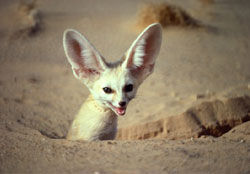
CONSERVATION NEWS
FENNEC FOX /
RED FOX

Success Story:
New Reserve Created

Partnership with
Sahara Conservation Fund
THE CONSERVE WILDLIFE
FOUNDATION OF NJ
Red Fox print benefits Fennec Fox Conservation


There is nothing more charming or emblematic of the romance of the Sahara than the little fennec fox. This tiny fox with the big ears is exquisitely adapted to the harsh arid environment of the world’s greatest desert. The Sahara has a rich complement of species like the fennec found nowhere else in the world. Ruppell’s and pale foxes, sand cats, African wild cats, caracal, striped hyena, golden jackal and the rare desert cheetah are just some of the examples. Virtually nothing is known about many of these species, including the status of the wild populations, which is why many of them are listed as “Data Deficient” instead of “Endangered” or “Threatened” by the IUCN. The Sahara Conservation Fund (SCF) hopes to change all that.
SCF has identified the Termit/Tin Toumma region of Eastern Niger as one of the last refuges for Sahelo-Saharan wildlife, including addax antelope (2/3 of the remaining wild population is found here), Dama gazelles, Nubian and Sudan bustards, and all the carnivores mentioned above. SCF’s field work over the past several years has brought us a better understanding of the population dynamics and ecology of the antelope in the region. The Republic of Niger has asked for help from SCF and the Convention on Migratory Species (CMS) to establish a wildlife reserve in this region. One of the key needs to move this reserve forward is a better understanding of the ecology of the region’s native carnivores and their impact on human activities in the area. The Termit/Tin Toumma region is used by nomadic people. A plan for the reserve must take into account their pastoral traditions and their concerns about carnivores to gain full cooperation from the local communities. We know very little about the extent to which carnivores prey on local livestock.
The Termit reserve represents a unique niche for small carnivores like the many foxes found here. It is extremely unusal to find this many canid (dog family) species in one area, especially in such a harsh environment, and it will be important to determine how they manage to coexist. The Sahara Conservation Fund (SCF) is partnering with Oxford University’s Wild Carnivore Research Unit (Wild CRU) and the Republic of Niger to study these desert carnivores. We will conduct surveys of carnivore distribution and abundance, data will be collected on their social organization, reproductive biology, feeding ecology and behavior which are lacking for many small canid species. We will also begin working with local people on alternate predator control methods that leave room for people and carnivores to coexist.
SCF is trying to bring attention to the silent crisis of extinction in the Sahara. To date, this region of the world has been largely overlooked and under-funded by the major aid agencies and conservation organizations worldwide. While there is good local interest in conservation in many parts of the Sahara, this region contains many of the poorest nations on the planet. Without outside assistance, the people of the Sahara will continue to struggle in their sincere efforts to conserve their wildlife. We run the risk of losing the fennec fox and its fellow Saharan carnivores before we ever come to understand their unique ecological roles! However, the fennec fox can serve as a flagship species bringing conservation and research efforts to the region and the proposed reserve. A viable reserve needs a full complement of native carnivore species, and, at the same time, the impact of those carnivores on traditional human activities within the proposed reserve must be addressed by a management plan that balances the needs of both. Our goal is to ensure a sustainable future for the rare and unique wildlife of Termit/Tin Toumma along with the people who share their land.
To find out more about the Niger carnivore project or other projects to conserve desert species,
http://www.saharaconservation.org
http://www.stlzoo.org/wildcareinstitute/saharanwildliferecoverycen.htm
© Phyllis Frazier. All rights reserved.
Photos for Red Fox/Fennec Fox project courtesy of SCF.



